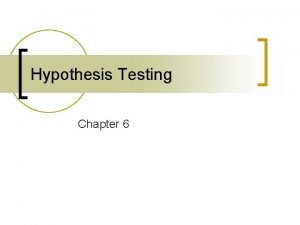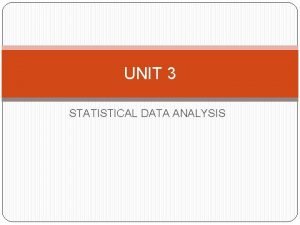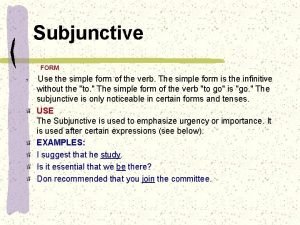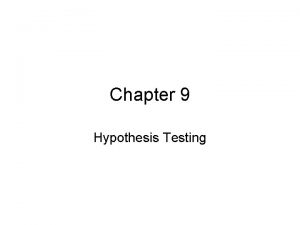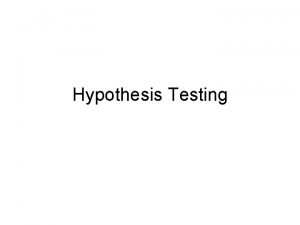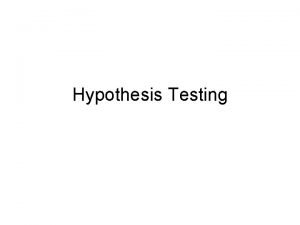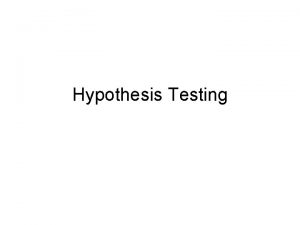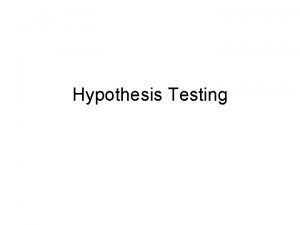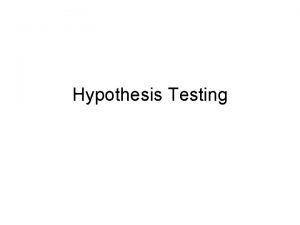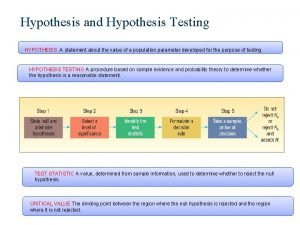Hypothesis Testing Major Steps Recommended Steps 1 State













- Slides: 13

Hypothesis Testing Major Steps

Recommended Steps 1. State the hypotheses. �Be sure to state both the null hypothesis and the alternative hypothesis, and identify which is the claim. H 0

Statistical Hypotheses �Null Hypothesis ◦ Either states that there is no difference between a parameter and a specific value or that there is no difference between parameters ◦ H 0: m ≤ 100 H 0: p = 60% and H 0: s 1 are examples of null hypotheses.

Statistical Hypotheses �Alternative Hypothesis ◦ Either states that there is a difference between a parameter and a specific value or that there is a difference between parameters ◦ H 1: m > 100 H 1: p 60% and H 1: s < 1 are examples of alternative hypotheses.

Recommended Steps 2. Design the study. �This step includes selecting the correct statistical test, choosing a level of significance, and formulating a plan to carry out the study. A t-test, a z-test, or a Chi-square test ─ that is the question!

Recommended Steps 2. Design the study. �The plan should include information such as the definition of the population, the way the sample will be selected, and the methods that will be used to gather the data.

Recommended Steps 3. Conduct the study and collect the data.

For instance… since the sample means vary about the population mean, even if the null hypothesis is true, the sample mean will not, in most cases, be exactly equal to the population mean. �So, . . .

� How close is close enough? � Is the difference “significant” or likely due to “chance”? � Just where does the researcher draw the line?

Recommended Steps 4. Evaluate the data. �The data should be tabulated in this step, and the statistical test should be conducted. Find the critical value(s). Compute the test value. Finally, decide whether to reject or not reject the null hypothesis.


Decision Issues �A Type I error occurs if one rejects the null hypothesis when it is true. �A Type II error occurs if one does not reject a null hypothesis when it is false.

Recommended Steps 5. Summarize the results. Write a specific conclusion involving the claim (which may or may not be the null hypothesis). Refer to our text for the types of conclusions which may be made.
 Six steps of hypothesis testing
Six steps of hypothesis testing Sources of hypothesis
Sources of hypothesis Steps in hypothesis testing ppt
Steps in hypothesis testing ppt Testability tips in software testing
Testability tips in software testing Zczc state graph
Zczc state graph Define null hypothesis
Define null hypothesis Null hypothesis vs alternative hypothesis
Null hypothesis vs alternative hypothesis Examples of null hypothesis
Examples of null hypothesis Protoplanet hypothesis weakness
Protoplanet hypothesis weakness Herold merisier
Herold merisier Subjunctive mood examples
Subjunctive mood examples Explain when rtv and anaerobic sealers are recommended.
Explain when rtv and anaerobic sealers are recommended. Fxq amadeus
Fxq amadeus What are the accenture delivery method 5 main focus areas?
What are the accenture delivery method 5 main focus areas?
